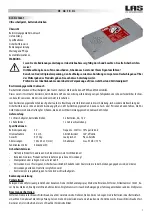
OPERATION
As the liquid level rises in the wet well, a hydrostatic
pressure on the flexible bulb is exerted. The hydrostatic
pressure tends to squeeze the bulb, causing a
displacement of its liquid. The displaced liquid rises in
the electrode housing toward the electrodes. The liquid
level within the electrode housing will always be equal to
the level of the liquid in which the controller is
submerged, since the density of both liquids are equal.
As the liquid within the electrode housing rises and falls,
it makes a and breaks electrical circuits with the
electrodes, thereby actuating the pump starters through
the controller relays.
CAUTION
This controller should not be used in liquids having a
temperature exceeding 140º F. or less than 35º F.
MAINTENANCE
The SEALTRODE r Series P Controller, if properly in-
stalled, requires little or no maintenance. It has no
moving parts, except for the control relays which should
be inspected semi-annually for worn or pitted contactors.
It is recommended that the operation of the controller be
observed for several complete operating cycles when
making routine maintenance and inspection of the pump.
REFILLING FLEXIBLE BULB:
The electrolytic solution
within the control bulb should seldom, if ever, be
replenished because of evaporation. However, should it
become necessary to replenish the liquid within the bulb,
proceed in the following manner:
1. Refer to installation print showing the setting of the
electrodes.
2. Note the setting of the highest electrode and what
circuit it controls.
WARNING
Before attempting repairs to installation, disconnect the
power supply. Controls are automatic. This prevents
accidental running of pump motor. Starting motor during
repair activities could damage pump and may cause
personal injury.
3. Disconnect all electrical devices (pump starters) which
are not controlled by the highest electrode to prevent
their operation during the process of refilling the bulb.
4. Fill the basin to the highest electrode setting and then
slowly pour distilled water thru the tee. Fill the
connection until the high electrode circuit operates.
When the circuit operates, add an additional quart of
water.
5. In the event that the bulb has been over-filled, and
the pumps do not cut-off, remove and empty the bulb
and refill as outlined on page 3 under the heading “Filling
Flexible Bulb”.
LOCATING TROUBLE
IF THE PUMP FAILS TO START:
1. Make sure sodium bicarbonate has been added to
water.
2. Check the electrical service, making sure the current
characteristics are the same as that stamped on the
control box nameplate.
3. Check to see if the control wiring is in accordance with
the wiring diagram supplied with controller.
4. Determine if the electrical power at the control box
has been interrupted or disconnected.
5. Check set screw (14) and make certain it is right.
6. Short circuit the pump start electrode terminals in the
control box with a piece of insulated wire. This should be
done by a qualified electrician. If the pump operates
check the following:
a. Inspect the wiring from the terminals in the control
box to the controller terminal housing making sure that
all connections are clean and tight. Look for broken
wires.
b. Check the wire connections at the electrodes to
see if they are broken.
c. Check to see if the flexible bulb has been
damaged. If the bulb is damaged, liquid from the basin
may have entered the housing and coated the
electrodes with grease or oil. Grease and oil will
insulate the electrodes.
d. Check the bulb for loss of electrolytic solution.
e. Check the setting of the pump cut-in electrode. It
may be set too high.
f.
Check for proper open venting of housing.
7. If the pump fails to operate after short circuiting the
electrode terminals in the control, check the following:
a. Check the ground wire, making sure that it is not
broken and terminal connections are clean and tight.
b. Check the control box for burned out transformer or
relay coils.
c. Check the relay contacts to see if they are corroded,
worn or pitted.
8. If the pump fails to cut off check the following:
a. Check the wire connections and insulation in the
terminal housing and control box, making sure they are
not forming a short circuit by being grounded to the box
or housing.
b. Check the electrodes, making sure they are properly
shielded. An electrode not properly shielded may form a
short circuit with the electrode housing.
c. Check the relay contacts in the control box to see if
they are stuck.
d. Too much liquid in the flexible bulb. Excessive liquid
in the bulb will keep the low pump cut-off electrode
submerged and the pump cut-in relay will not open.
4848247
4
Summary of Contents for Sealtrode P Series
Page 5: ...DT 4848247 5 ...


























